Learning and Development: Investment for Organizations in HRM
VerifiedAdded on 2022/10/13
|7
|2088
|18
Report
AI Summary
This report delves into the critical role of learning and development (L&D) in contemporary people management, emphasizing its significance for organizational effectiveness and employee performance. It explores the debate of whether L&D is a cost or a strategic investment, arguing that it is a long-term investment that enhances employee skills, increases productivity, and fosters a skilled workforce. The report examines the importance of a skilled workforce in achieving organizational objectives and discusses the phases of a training model within human resource management (HRM). It highlights how investing in L&D programs can improve financial performance, increase employee loyalty, and reduce errors, ultimately leading to organizational success. The report concludes that L&D is a key component of contemporary people management, essential for building a talented workforce and maintaining long-term customer relationships.
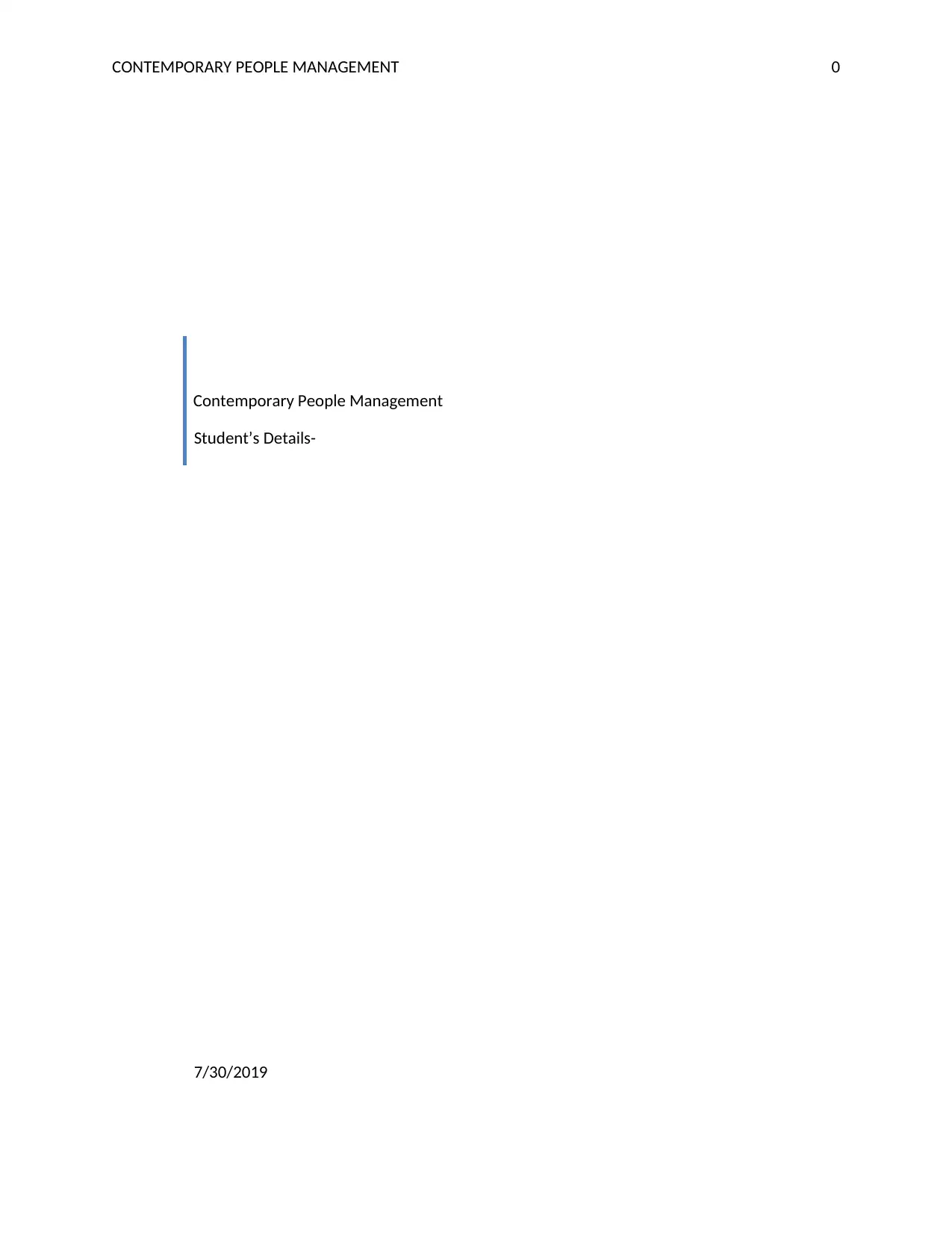
CONTEMPORARY PEOPLE MANAGEMENT 0
Contemporary People Management
Student’s Details-
7/30/2019
Contemporary People Management
Student’s Details-
7/30/2019
Paraphrase This Document
Need a fresh take? Get an instant paraphrase of this document with our AI Paraphraser

CONTEMPORARY PEOPLE MANAGEMENT 1
Contemporary People Management
Learning and development is crucial for every organization and is a leading factor the
effectiveness of organization’s performance. It refers to an increase in the knowledge and skills
of people in the organization in order to facilitate an improvement in the performance of the
overall organization. Learning and development is often called as training and development
which is a primary factor in attaining the goals and objectives of the organization (Green &
Hopwood, 2016). Every organization aims to run various learning and development programs
for their employees which increases job performance and also the productivity of the
organization. When employees are skilled, they are treated as assets of the organization and
therefore organizations make huge investment in the improving the performance of the
employees through training and development as it will ultimately leads in the attainment of high
level of performance (Torraco, 2016). Here, the discussion is regarding the learning and
development to determine whether it is cost or investment for the organizations along with this
the importance of skilled workforce in contemporary people management is also discussed in
following paths.
There is wider significance of training and development in the organizations due to the
technological changes and introduction of new methods. Training and development is important
aspect of human resource management where human resource managers play a very vital role.
Human resource managers are responsible for providing training and development to the
employees in order to develop innovative and analytical skills of the workforce. Rather, the
process requires cost to be incurred. Once a candidate is hired, HR managers have to spend time
and money on the training and development in order to make them ideal for the job that they are
performing. The managers have to incur a significant amount of money on the establishment of
training and development programs and the procurement of eligible trainers who could train
them (Hassan, 2016).
Apart from the cost involved in training of the employees, it is considered as long term
investment for the organizations. When employees are trained in a creative manner, the
employees are more likely to give better results in future. Training and development leads to
skilled workforce which can lead to increase sales of the company. The training programs not
Contemporary People Management
Learning and development is crucial for every organization and is a leading factor the
effectiveness of organization’s performance. It refers to an increase in the knowledge and skills
of people in the organization in order to facilitate an improvement in the performance of the
overall organization. Learning and development is often called as training and development
which is a primary factor in attaining the goals and objectives of the organization (Green &
Hopwood, 2016). Every organization aims to run various learning and development programs
for their employees which increases job performance and also the productivity of the
organization. When employees are skilled, they are treated as assets of the organization and
therefore organizations make huge investment in the improving the performance of the
employees through training and development as it will ultimately leads in the attainment of high
level of performance (Torraco, 2016). Here, the discussion is regarding the learning and
development to determine whether it is cost or investment for the organizations along with this
the importance of skilled workforce in contemporary people management is also discussed in
following paths.
There is wider significance of training and development in the organizations due to the
technological changes and introduction of new methods. Training and development is important
aspect of human resource management where human resource managers play a very vital role.
Human resource managers are responsible for providing training and development to the
employees in order to develop innovative and analytical skills of the workforce. Rather, the
process requires cost to be incurred. Once a candidate is hired, HR managers have to spend time
and money on the training and development in order to make them ideal for the job that they are
performing. The managers have to incur a significant amount of money on the establishment of
training and development programs and the procurement of eligible trainers who could train
them (Hassan, 2016).
Apart from the cost involved in training of the employees, it is considered as long term
investment for the organizations. When employees are trained in a creative manner, the
employees are more likely to give better results in future. Training and development leads to
skilled workforce which can lead to increase sales of the company. The training programs not
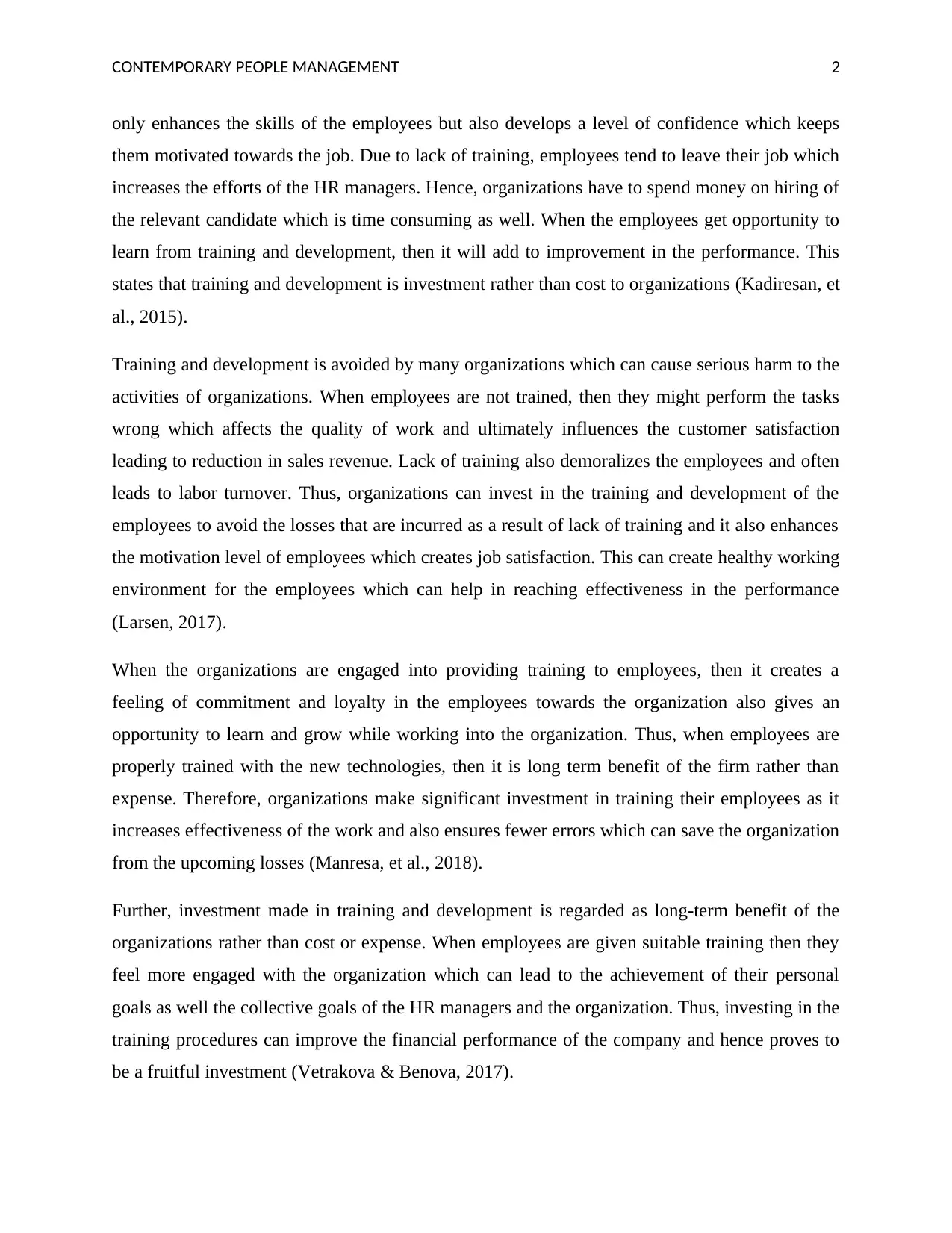
CONTEMPORARY PEOPLE MANAGEMENT 2
only enhances the skills of the employees but also develops a level of confidence which keeps
them motivated towards the job. Due to lack of training, employees tend to leave their job which
increases the efforts of the HR managers. Hence, organizations have to spend money on hiring of
the relevant candidate which is time consuming as well. When the employees get opportunity to
learn from training and development, then it will add to improvement in the performance. This
states that training and development is investment rather than cost to organizations (Kadiresan, et
al., 2015).
Training and development is avoided by many organizations which can cause serious harm to the
activities of organizations. When employees are not trained, then they might perform the tasks
wrong which affects the quality of work and ultimately influences the customer satisfaction
leading to reduction in sales revenue. Lack of training also demoralizes the employees and often
leads to labor turnover. Thus, organizations can invest in the training and development of the
employees to avoid the losses that are incurred as a result of lack of training and it also enhances
the motivation level of employees which creates job satisfaction. This can create healthy working
environment for the employees which can help in reaching effectiveness in the performance
(Larsen, 2017).
When the organizations are engaged into providing training to employees, then it creates a
feeling of commitment and loyalty in the employees towards the organization also gives an
opportunity to learn and grow while working into the organization. Thus, when employees are
properly trained with the new technologies, then it is long term benefit of the firm rather than
expense. Therefore, organizations make significant investment in training their employees as it
increases effectiveness of the work and also ensures fewer errors which can save the organization
from the upcoming losses (Manresa, et al., 2018).
Further, investment made in training and development is regarded as long-term benefit of the
organizations rather than cost or expense. When employees are given suitable training then they
feel more engaged with the organization which can lead to the achievement of their personal
goals as well the collective goals of the HR managers and the organization. Thus, investing in the
training procedures can improve the financial performance of the company and hence proves to
be a fruitful investment (Vetrakova & Benova, 2017).
only enhances the skills of the employees but also develops a level of confidence which keeps
them motivated towards the job. Due to lack of training, employees tend to leave their job which
increases the efforts of the HR managers. Hence, organizations have to spend money on hiring of
the relevant candidate which is time consuming as well. When the employees get opportunity to
learn from training and development, then it will add to improvement in the performance. This
states that training and development is investment rather than cost to organizations (Kadiresan, et
al., 2015).
Training and development is avoided by many organizations which can cause serious harm to the
activities of organizations. When employees are not trained, then they might perform the tasks
wrong which affects the quality of work and ultimately influences the customer satisfaction
leading to reduction in sales revenue. Lack of training also demoralizes the employees and often
leads to labor turnover. Thus, organizations can invest in the training and development of the
employees to avoid the losses that are incurred as a result of lack of training and it also enhances
the motivation level of employees which creates job satisfaction. This can create healthy working
environment for the employees which can help in reaching effectiveness in the performance
(Larsen, 2017).
When the organizations are engaged into providing training to employees, then it creates a
feeling of commitment and loyalty in the employees towards the organization also gives an
opportunity to learn and grow while working into the organization. Thus, when employees are
properly trained with the new technologies, then it is long term benefit of the firm rather than
expense. Therefore, organizations make significant investment in training their employees as it
increases effectiveness of the work and also ensures fewer errors which can save the organization
from the upcoming losses (Manresa, et al., 2018).
Further, investment made in training and development is regarded as long-term benefit of the
organizations rather than cost or expense. When employees are given suitable training then they
feel more engaged with the organization which can lead to the achievement of their personal
goals as well the collective goals of the HR managers and the organization. Thus, investing in the
training procedures can improve the financial performance of the company and hence proves to
be a fruitful investment (Vetrakova & Benova, 2017).
⊘ This is a preview!⊘
Do you want full access?
Subscribe today to unlock all pages.

Trusted by 1+ million students worldwide
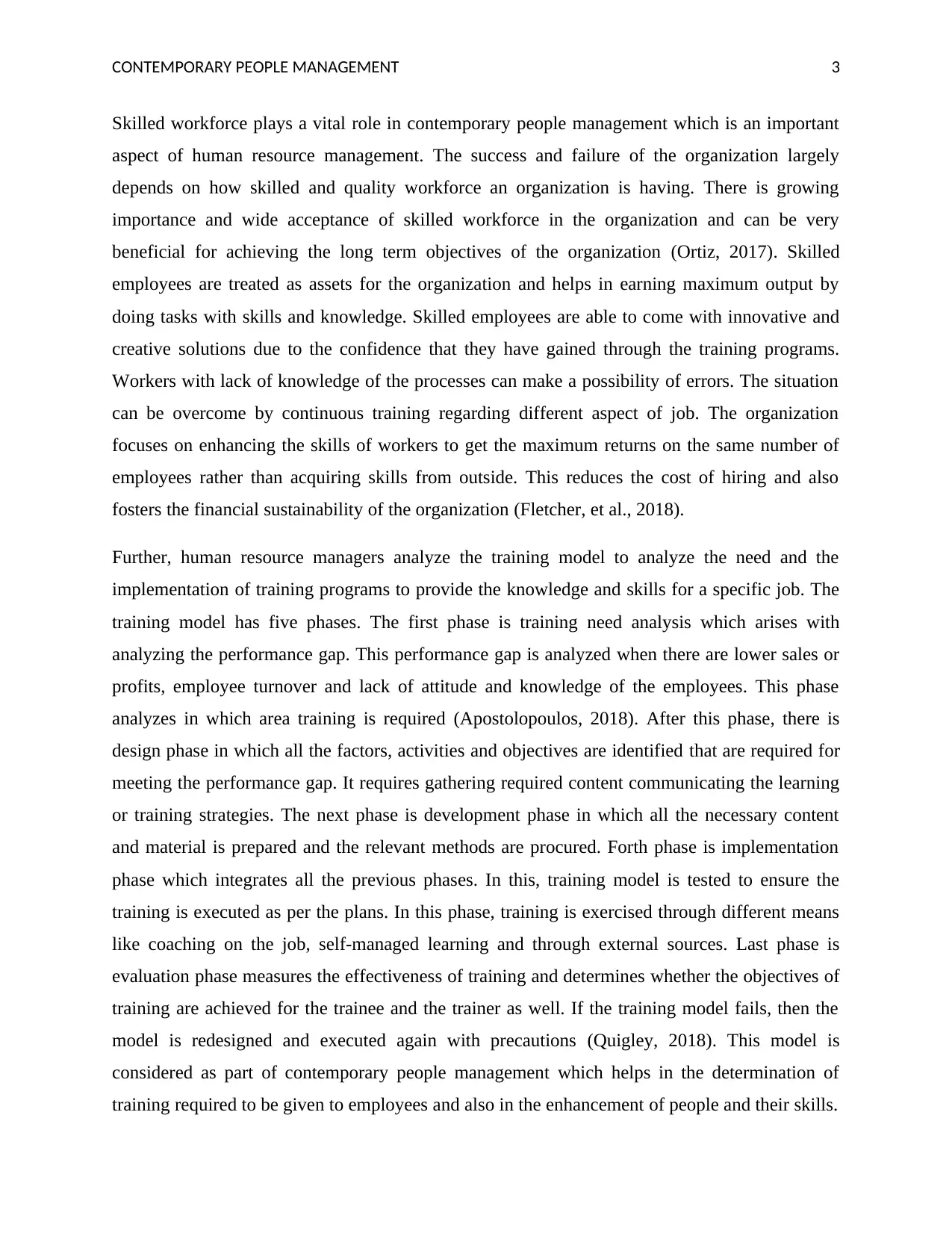
CONTEMPORARY PEOPLE MANAGEMENT 3
Skilled workforce plays a vital role in contemporary people management which is an important
aspect of human resource management. The success and failure of the organization largely
depends on how skilled and quality workforce an organization is having. There is growing
importance and wide acceptance of skilled workforce in the organization and can be very
beneficial for achieving the long term objectives of the organization (Ortiz, 2017). Skilled
employees are treated as assets for the organization and helps in earning maximum output by
doing tasks with skills and knowledge. Skilled employees are able to come with innovative and
creative solutions due to the confidence that they have gained through the training programs.
Workers with lack of knowledge of the processes can make a possibility of errors. The situation
can be overcome by continuous training regarding different aspect of job. The organization
focuses on enhancing the skills of workers to get the maximum returns on the same number of
employees rather than acquiring skills from outside. This reduces the cost of hiring and also
fosters the financial sustainability of the organization (Fletcher, et al., 2018).
Further, human resource managers analyze the training model to analyze the need and the
implementation of training programs to provide the knowledge and skills for a specific job. The
training model has five phases. The first phase is training need analysis which arises with
analyzing the performance gap. This performance gap is analyzed when there are lower sales or
profits, employee turnover and lack of attitude and knowledge of the employees. This phase
analyzes in which area training is required (Apostolopoulos, 2018). After this phase, there is
design phase in which all the factors, activities and objectives are identified that are required for
meeting the performance gap. It requires gathering required content communicating the learning
or training strategies. The next phase is development phase in which all the necessary content
and material is prepared and the relevant methods are procured. Forth phase is implementation
phase which integrates all the previous phases. In this, training model is tested to ensure the
training is executed as per the plans. In this phase, training is exercised through different means
like coaching on the job, self-managed learning and through external sources. Last phase is
evaluation phase measures the effectiveness of training and determines whether the objectives of
training are achieved for the trainee and the trainer as well. If the training model fails, then the
model is redesigned and executed again with precautions (Quigley, 2018). This model is
considered as part of contemporary people management which helps in the determination of
training required to be given to employees and also in the enhancement of people and their skills.
Skilled workforce plays a vital role in contemporary people management which is an important
aspect of human resource management. The success and failure of the organization largely
depends on how skilled and quality workforce an organization is having. There is growing
importance and wide acceptance of skilled workforce in the organization and can be very
beneficial for achieving the long term objectives of the organization (Ortiz, 2017). Skilled
employees are treated as assets for the organization and helps in earning maximum output by
doing tasks with skills and knowledge. Skilled employees are able to come with innovative and
creative solutions due to the confidence that they have gained through the training programs.
Workers with lack of knowledge of the processes can make a possibility of errors. The situation
can be overcome by continuous training regarding different aspect of job. The organization
focuses on enhancing the skills of workers to get the maximum returns on the same number of
employees rather than acquiring skills from outside. This reduces the cost of hiring and also
fosters the financial sustainability of the organization (Fletcher, et al., 2018).
Further, human resource managers analyze the training model to analyze the need and the
implementation of training programs to provide the knowledge and skills for a specific job. The
training model has five phases. The first phase is training need analysis which arises with
analyzing the performance gap. This performance gap is analyzed when there are lower sales or
profits, employee turnover and lack of attitude and knowledge of the employees. This phase
analyzes in which area training is required (Apostolopoulos, 2018). After this phase, there is
design phase in which all the factors, activities and objectives are identified that are required for
meeting the performance gap. It requires gathering required content communicating the learning
or training strategies. The next phase is development phase in which all the necessary content
and material is prepared and the relevant methods are procured. Forth phase is implementation
phase which integrates all the previous phases. In this, training model is tested to ensure the
training is executed as per the plans. In this phase, training is exercised through different means
like coaching on the job, self-managed learning and through external sources. Last phase is
evaluation phase measures the effectiveness of training and determines whether the objectives of
training are achieved for the trainee and the trainer as well. If the training model fails, then the
model is redesigned and executed again with precautions (Quigley, 2018). This model is
considered as part of contemporary people management which helps in the determination of
training required to be given to employees and also in the enhancement of people and their skills.
Paraphrase This Document
Need a fresh take? Get an instant paraphrase of this document with our AI Paraphraser
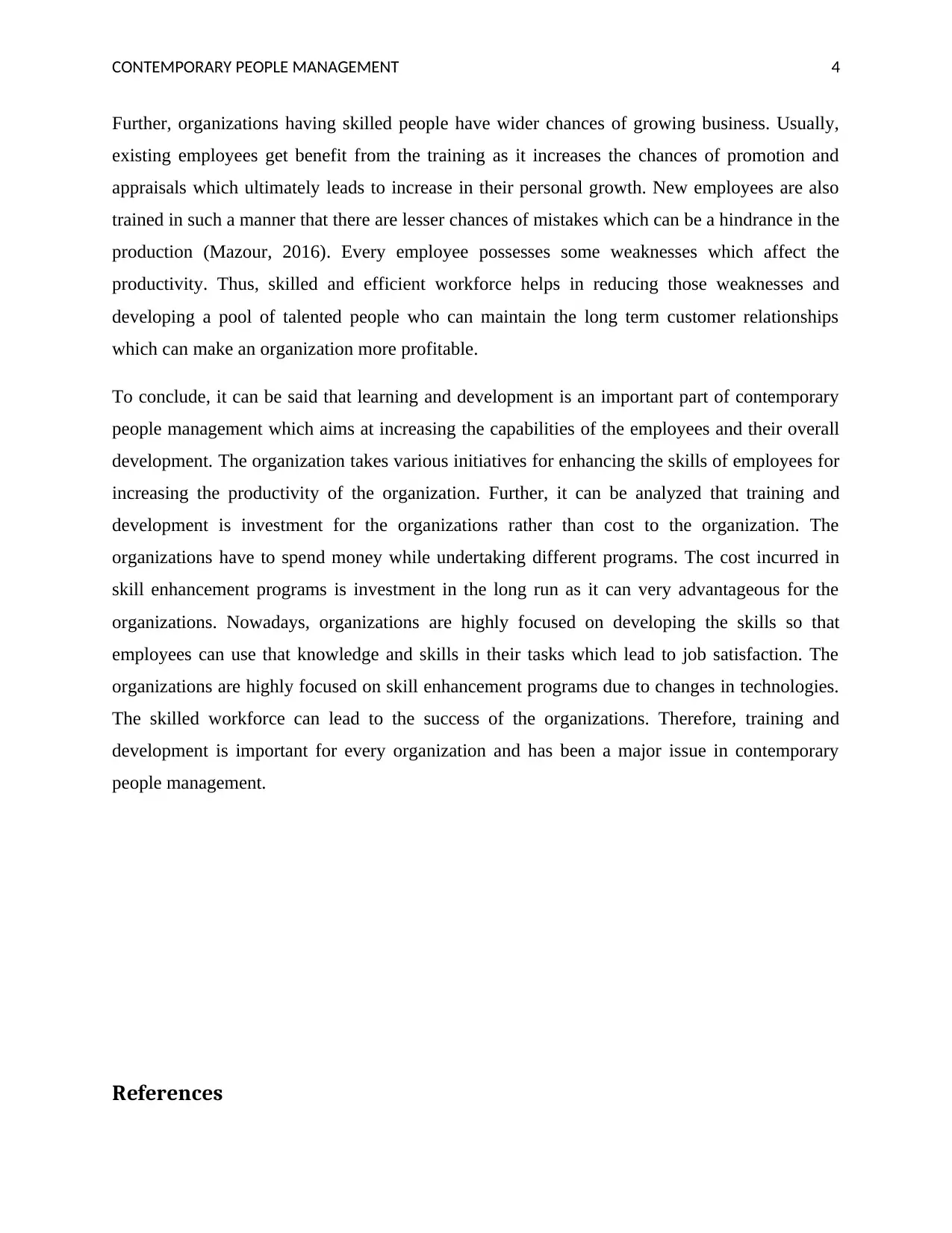
CONTEMPORARY PEOPLE MANAGEMENT 4
Further, organizations having skilled people have wider chances of growing business. Usually,
existing employees get benefit from the training as it increases the chances of promotion and
appraisals which ultimately leads to increase in their personal growth. New employees are also
trained in such a manner that there are lesser chances of mistakes which can be a hindrance in the
production (Mazour, 2016). Every employee possesses some weaknesses which affect the
productivity. Thus, skilled and efficient workforce helps in reducing those weaknesses and
developing a pool of talented people who can maintain the long term customer relationships
which can make an organization more profitable.
To conclude, it can be said that learning and development is an important part of contemporary
people management which aims at increasing the capabilities of the employees and their overall
development. The organization takes various initiatives for enhancing the skills of employees for
increasing the productivity of the organization. Further, it can be analyzed that training and
development is investment for the organizations rather than cost to the organization. The
organizations have to spend money while undertaking different programs. The cost incurred in
skill enhancement programs is investment in the long run as it can very advantageous for the
organizations. Nowadays, organizations are highly focused on developing the skills so that
employees can use that knowledge and skills in their tasks which lead to job satisfaction. The
organizations are highly focused on skill enhancement programs due to changes in technologies.
The skilled workforce can lead to the success of the organizations. Therefore, training and
development is important for every organization and has been a major issue in contemporary
people management.
References
Further, organizations having skilled people have wider chances of growing business. Usually,
existing employees get benefit from the training as it increases the chances of promotion and
appraisals which ultimately leads to increase in their personal growth. New employees are also
trained in such a manner that there are lesser chances of mistakes which can be a hindrance in the
production (Mazour, 2016). Every employee possesses some weaknesses which affect the
productivity. Thus, skilled and efficient workforce helps in reducing those weaknesses and
developing a pool of talented people who can maintain the long term customer relationships
which can make an organization more profitable.
To conclude, it can be said that learning and development is an important part of contemporary
people management which aims at increasing the capabilities of the employees and their overall
development. The organization takes various initiatives for enhancing the skills of employees for
increasing the productivity of the organization. Further, it can be analyzed that training and
development is investment for the organizations rather than cost to the organization. The
organizations have to spend money while undertaking different programs. The cost incurred in
skill enhancement programs is investment in the long run as it can very advantageous for the
organizations. Nowadays, organizations are highly focused on developing the skills so that
employees can use that knowledge and skills in their tasks which lead to job satisfaction. The
organizations are highly focused on skill enhancement programs due to changes in technologies.
The skilled workforce can lead to the success of the organizations. Therefore, training and
development is important for every organization and has been a major issue in contemporary
people management.
References
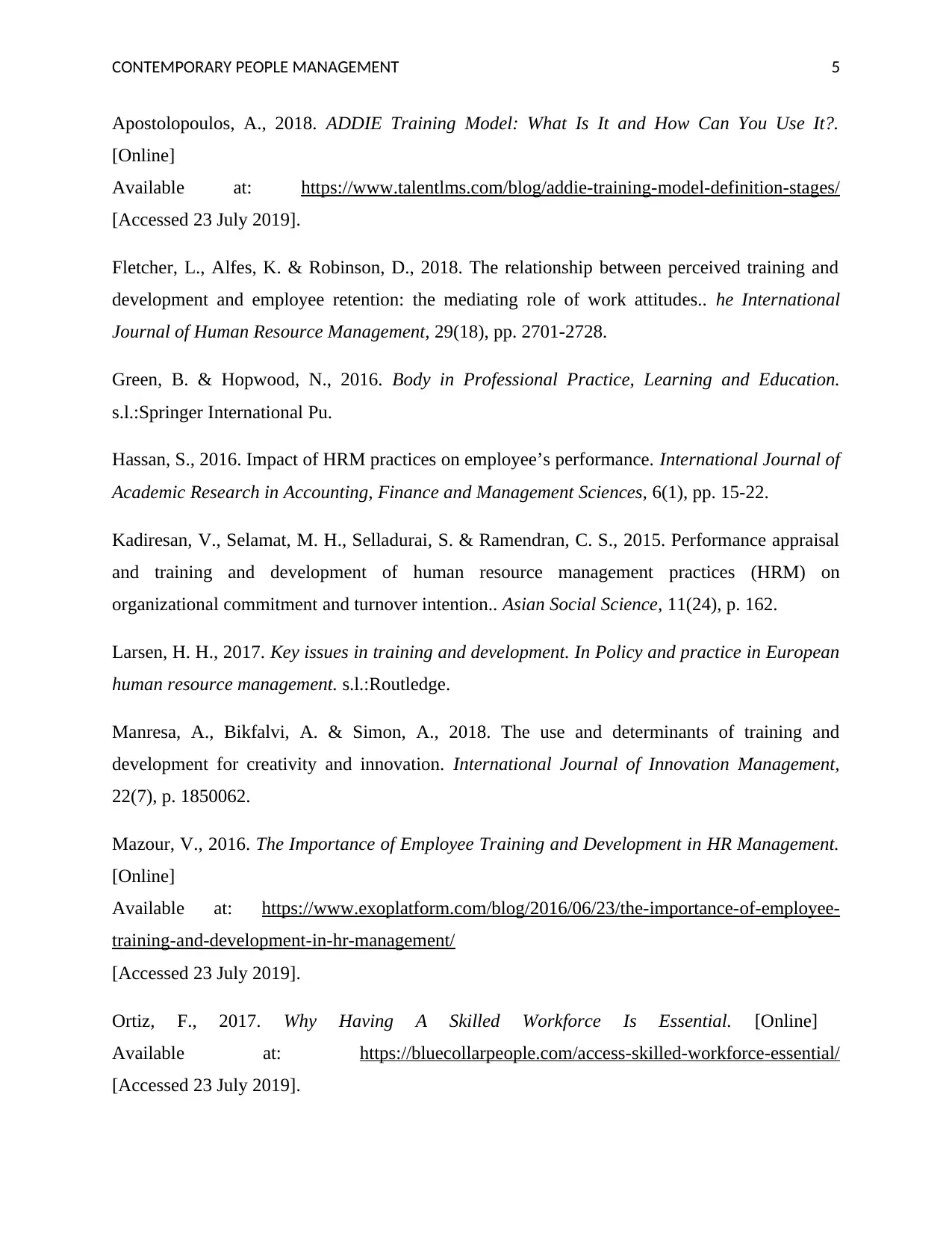
CONTEMPORARY PEOPLE MANAGEMENT 5
Apostolopoulos, A., 2018. ADDIE Training Model: What Is It and How Can You Use It?.
[Online]
Available at: https://www.talentlms.com/blog/addie-training-model-definition-stages/
[Accessed 23 July 2019].
Fletcher, L., Alfes, K. & Robinson, D., 2018. The relationship between perceived training and
development and employee retention: the mediating role of work attitudes.. he International
Journal of Human Resource Management, 29(18), pp. 2701-2728.
Green, B. & Hopwood, N., 2016. Body in Professional Practice, Learning and Education.
s.l.:Springer International Pu.
Hassan, S., 2016. Impact of HRM practices on employee’s performance. International Journal of
Academic Research in Accounting, Finance and Management Sciences, 6(1), pp. 15-22.
Kadiresan, V., Selamat, M. H., Selladurai, S. & Ramendran, C. S., 2015. Performance appraisal
and training and development of human resource management practices (HRM) on
organizational commitment and turnover intention.. Asian Social Science, 11(24), p. 162.
Larsen, H. H., 2017. Key issues in training and development. In Policy and practice in European
human resource management. s.l.:Routledge.
Manresa, A., Bikfalvi, A. & Simon, A., 2018. The use and determinants of training and
development for creativity and innovation. International Journal of Innovation Management,
22(7), p. 1850062.
Mazour, V., 2016. The Importance of Employee Training and Development in HR Management.
[Online]
Available at: https://www.exoplatform.com/blog/2016/06/23/the-importance-of-employee-
training-and-development-in-hr-management/
[Accessed 23 July 2019].
Ortiz, F., 2017. Why Having A Skilled Workforce Is Essential. [Online]
Available at: https://bluecollarpeople.com/access-skilled-workforce-essential/
[Accessed 23 July 2019].
Apostolopoulos, A., 2018. ADDIE Training Model: What Is It and How Can You Use It?.
[Online]
Available at: https://www.talentlms.com/blog/addie-training-model-definition-stages/
[Accessed 23 July 2019].
Fletcher, L., Alfes, K. & Robinson, D., 2018. The relationship between perceived training and
development and employee retention: the mediating role of work attitudes.. he International
Journal of Human Resource Management, 29(18), pp. 2701-2728.
Green, B. & Hopwood, N., 2016. Body in Professional Practice, Learning and Education.
s.l.:Springer International Pu.
Hassan, S., 2016. Impact of HRM practices on employee’s performance. International Journal of
Academic Research in Accounting, Finance and Management Sciences, 6(1), pp. 15-22.
Kadiresan, V., Selamat, M. H., Selladurai, S. & Ramendran, C. S., 2015. Performance appraisal
and training and development of human resource management practices (HRM) on
organizational commitment and turnover intention.. Asian Social Science, 11(24), p. 162.
Larsen, H. H., 2017. Key issues in training and development. In Policy and practice in European
human resource management. s.l.:Routledge.
Manresa, A., Bikfalvi, A. & Simon, A., 2018. The use and determinants of training and
development for creativity and innovation. International Journal of Innovation Management,
22(7), p. 1850062.
Mazour, V., 2016. The Importance of Employee Training and Development in HR Management.
[Online]
Available at: https://www.exoplatform.com/blog/2016/06/23/the-importance-of-employee-
training-and-development-in-hr-management/
[Accessed 23 July 2019].
Ortiz, F., 2017. Why Having A Skilled Workforce Is Essential. [Online]
Available at: https://bluecollarpeople.com/access-skilled-workforce-essential/
[Accessed 23 July 2019].
⊘ This is a preview!⊘
Do you want full access?
Subscribe today to unlock all pages.

Trusted by 1+ million students worldwide
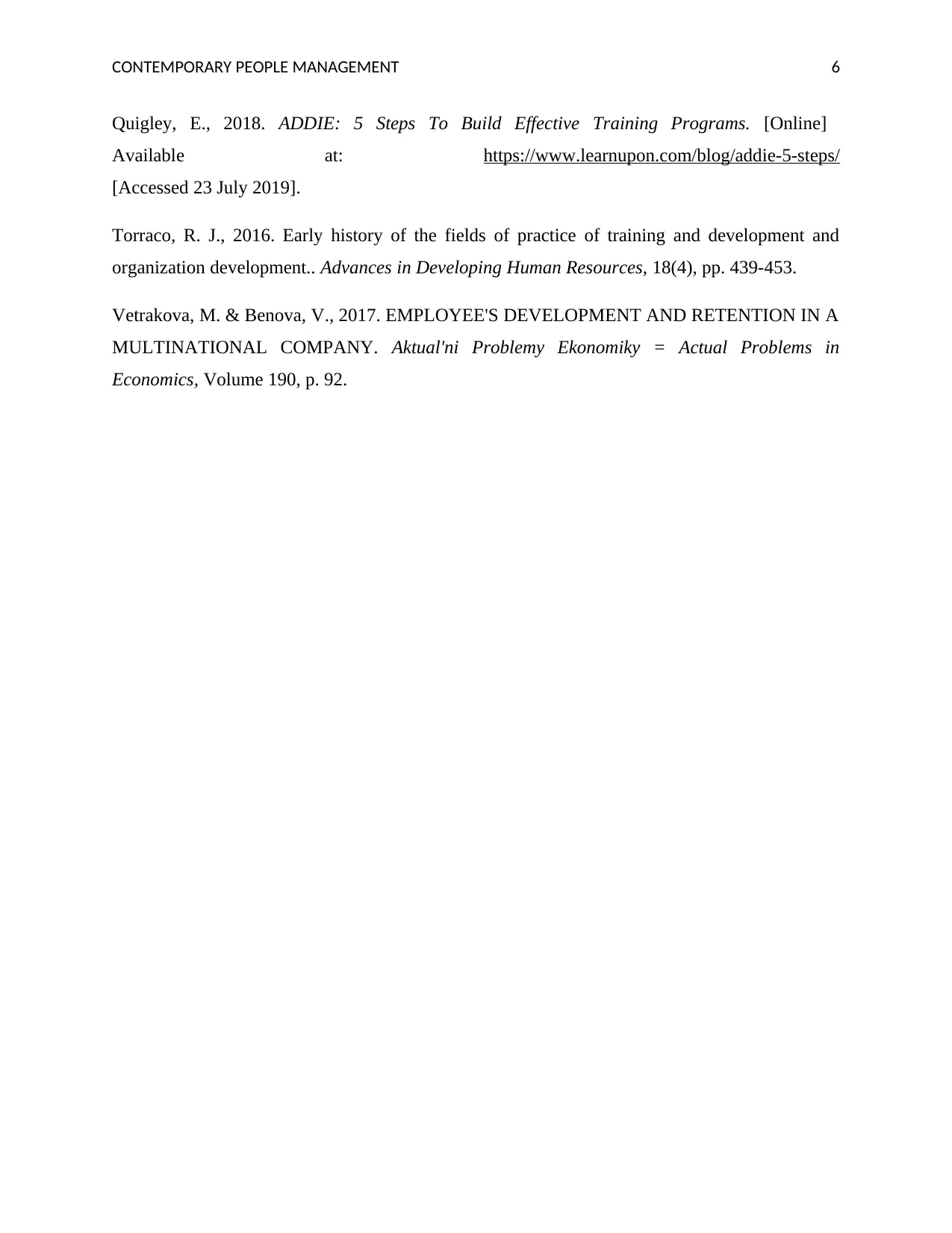
CONTEMPORARY PEOPLE MANAGEMENT 6
Quigley, E., 2018. ADDIE: 5 Steps To Build Effective Training Programs. [Online]
Available at: https://www.learnupon.com/blog/addie-5-steps/
[Accessed 23 July 2019].
Torraco, R. J., 2016. Early history of the fields of practice of training and development and
organization development.. Advances in Developing Human Resources, 18(4), pp. 439-453.
Vetrakova, M. & Benova, V., 2017. EMPLOYEE'S DEVELOPMENT AND RETENTION IN A
MULTINATIONAL COMPANY. Aktual'ni Problemy Ekonomiky = Actual Problems in
Economics, Volume 190, p. 92.
Quigley, E., 2018. ADDIE: 5 Steps To Build Effective Training Programs. [Online]
Available at: https://www.learnupon.com/blog/addie-5-steps/
[Accessed 23 July 2019].
Torraco, R. J., 2016. Early history of the fields of practice of training and development and
organization development.. Advances in Developing Human Resources, 18(4), pp. 439-453.
Vetrakova, M. & Benova, V., 2017. EMPLOYEE'S DEVELOPMENT AND RETENTION IN A
MULTINATIONAL COMPANY. Aktual'ni Problemy Ekonomiky = Actual Problems in
Economics, Volume 190, p. 92.
1 out of 7
Related Documents
Your All-in-One AI-Powered Toolkit for Academic Success.
+13062052269
info@desklib.com
Available 24*7 on WhatsApp / Email
![[object Object]](/_next/static/media/star-bottom.7253800d.svg)
Unlock your academic potential
Copyright © 2020–2025 A2Z Services. All Rights Reserved. Developed and managed by ZUCOL.


